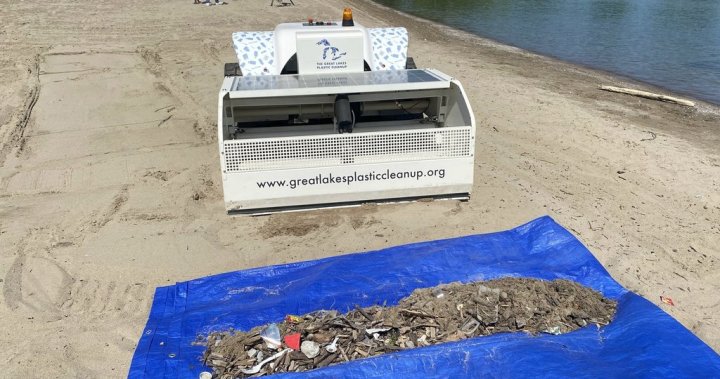Canada’s first beach cleaning robot is coming to Ontario’s parks this summer

Don’t be alarmed if you see a Zamboni-like rover roaming Ontario’s shores this summer – it’s a beach cleaning robot being tested in some provincial parks.
The robot, called a BeBot, is a remotely operated and fully electric machine that removes plastic, glass, metal, paper and other debris from beaches with sand-sifting technology.
“This technology allows us to capture some of the larger pieces of plastic before they actually enter the water,” said Melissa DeYoung, CEO of environmental organization Pollution Probe, which launched the BeBot in partnership with the Ontario Ministry of the Environment, Conservation and Parks.
DeYoung said it is “critically important” to remove litter and plastic before they enters lakes since they commonly break down into microplastics that can impact wildlife in the water.
“We’ll never be able to remove all of the plastic that’s found in the environment, but what we can do is collect data on the types of plastic we’re finding and then we have a very good sense of what the sources might be and where that plastic might be coming from,” said DeYoung.
The BeBot can clean up to 3,000 square metres per hour for up to eight hours and can remove the equivalent of around 19 bowling balls worth of plastic in one use, said DeYoung. The robot is battery-powered with a solar panel on the back and has a top speed of just below three kilometres per hour.

Get breaking National news
For news impacting Canada and around the world, sign up for breaking news alerts delivered directly to you when they happen.
The BeBot began its litter-cleaning work on the shores of Lake Simcoe at Sibbald Point Provincial Park this week, and will make its way to Inverhuron Provincial Park on Lake Huron in the next month.
Then, it will head to Lake Erie’s Long Point Provincial Park in late July and August, and Sandbanks Provincial Park and Darlington Provincial Park on Lake Ontario near the end of the summer.
While removing litter is its main job, DeYoung said the robot’s tour across the province also aims to encourage people to reduce waste.
“Sometimes people think we don’t have an issue because they can’t spot that plastic in the water,” DeYoung said.
“So having this technology that’s highly visible out on the beach while we’re working invites people to come in and discuss what we’re doing and then we can have those types of conversations that are required to have long-term solutions.”
Pollution Probe first launched its initiative to remove plastic from the Great Lakes – called The Great Lakes Plastic Cleanup – in 2020 alongside the Council of the Great Lakes Region.
DeYoung said the group had previously piloted the BeBot in the United States and was looking to find partners to bring it to Canada, leading to its collaboration with the Ontario government and Unsmoke Canada.
Andrew Dowie, parliamentary assistant to Environment Minister Todd McCarthy, said the Ontario government has provided almost $1 million to Pollution Probe’s efforts to tackle plastic pollution around the Great Lakes since 2021.
The beach cleaning robot will join more than 160 plastic capturing technologies already in use by Pollution Probe, DeYoung said.
© 2025 The Canadian Press


Swaths of southern Ontario could see severe thunderstorms and flash floods on Sunday amid extreme heat.
Environment and Climate Change Canada has issued heat warnings and thunderstorm watches for parts of the province, as well as a thunderstorm warning for Stirling, Tweed and Madoc.

Get daily National news
Get the day’s top news, political, economic, and current affairs headlines, delivered to your inbox once a day.
Forecasters say the area halfway between Toronto and Ottawa could see wind gusts up to 90 kilometres per hour and hail the size of nickels.
Meanwhile, police in Toronto say they received reports of water pooling on the Don Valley Parkway on Sunday morning.
A thunderstorm watch was in effect for the city, and police say some lanes of the DVP were restricted.
The heat in southern Ontario, where humidex values have reached 40 C, could last until Thursday.
© 2025 The Canadian Press

Residents of a tiny rural community in eastern Ontario pressed police on Saturday for answers about a disturbing attack on a young girl that investigators believed was caused by an animal — until they arrested a teenager in the case.
Nearly 100 people filled a small community centre in Quadeville, about 170 kilometres west of Ottawa, for a town hall organized by Ontario Provincial Police to address residents’ questions and concerns about their investigation.
Some have asked why the OPP alerted the community about a suspected animal attack on the eight-year-old girl before announcing two weeks later that a 17-year-old boy had been charged with sexual assault and attempted murder.
Police have said that they never ruled out other possibilities, and that their initial theory was supported by medical and pathology experts.
At Saturday evening’s town hall, police did not divulge any new information about the case that is now before the courts, but sought to assure residents they did everything they could to keep them informed throughout the investigation.
The community centre was packed, with no empty seats to be found. As people filed in, the temperature in the room started to increase on a sweltering evening, especially after someone shut off the portable air conditioning unit that was making noise.
“It’s a very traumatic time for this community because everyone knows everyone involved,” OPP Supt. Derek Needham said at the meeting punctuated by some tense moments.
When police opened the floor for questions, a man who identified himself as a relative of the victim asked why it took a long time for police to respond when the girl was initially reported missing on June 23, after she was last seen at a local store.

Police replied that it took time to bring officers to the scene to search the area.
“I could’ve done my own investigation,” said the man, adding that he lives three hours away.

Get daily National news
Get the day’s top news, political, economic, and current affairs headlines, delivered to your inbox once a day.
The OPP have said that they began their search for the missing child around 9 p.m. on June 23, and found her with life-threatening injuries not long after midnight.
Police asked people to keep their small children indoors amid fears of an animal attack but as their investigation continued, they discovered that there were no traces of animal DNA from the victim’s wounds. Police have not said what kind of evidence led them to arrest the teenage suspect, who cannot be named under the Youth Criminal Justice Act.
Town hall attendee Sandy Musclow asked police how members of the community should interact with the families of the young girl and the suspect.
“A whole lot of healing needs to take place,” Needham said, adding that the best thing for families to do is reach out and have open communication.
After the town hall ended, Musclow said “it’s been a bit difficult to figure out” how to support both families.
“I’ve grown up with them and we really want to make sure that we feel like everyone can feel the pain and move forward together as a community,” she said.

Musclow said that although residents didn’t get much information about the police investigation at the town hall, she was glad to see the community come together. She also pointed to various fundraising efforts for the girl, who remains in hospital, and her family.
“I just feel that the police did a really good job at giving us some solace that they did the right thing for us and they did everything as timely as they could and they were really looking into everyone’s interest,” Musclow said.
OPP spokesperson Bill Dickson told reporters on Saturday that police were compelled to warn the public about a possible animal attack in the early stages of the investigation, even if they weren’t sure that was the case.
“We couldn’t undersell it because if we didn’t say something and warn people and it was an animal and another child was attacked, that would be horrible,” he said.
Dickson said one of the local churches is bringing in counsellors to work with the community and counselling services from the OPP will also be available.
© 2025 The Canadian Press

A new poll by Leger has found that Quebec residents are the happiest in Canada.
The web survey of nearly 40,000 Canadians found that Quebecers rated their happiness at an average of 72.4 out of 100, which is well above the national average.
New Brunswick followed Quebec with an average of 70.2, while Manitoba and Prince Edward Island finished at the bottom of the list.
Mississauga, Ont. had the highest happiness rating of the 10 largest cities, while Toronto was lowest.
Montreal finished second in the category.
The survey found that 49 per cent of respondents said their happiness level was unchanged over the past year, while 23 per said they were happier and 28 per cent said they were less happy.
“These results reveal a population that is both resilient and tested, affected by everyday uncertainty and challenges,” Leger’s executive summary read. “Happiness, while holding its ground overall, shows signs of fragility.”

Get breaking National news
For news impacting Canada and around the world, sign up for breaking news alerts delivered directly to you when they happen.
The survey found that people in the 18-to-24 and 24-to-34-year-old categories were more likely to report improved feelings of well-being, even if their overall happiness score remained below the national average.
In contrast, people in the 35-to-44 and 45-to-54 age brackets were more likely to report their happiness had deteriorated.
“There is a sense of well-being emerging among younger age groups,” the summary read. “However, this also highlights the importance of supporting adults in mid-life, who are more vulnerable to the pressures of working life.”
Quebec, New Brunswick and Newfoundland and Labrador were the three provinces with happiness levels above the national average of 68.7. They were followed, in descending order, by Saskatchewan, Nova Scotia, Alberta, British Columbia, Ontario, Manitoba and P.E.I. The territories were not included in the survey.
In the survey of the 10 largest cities, Mississauga and Montreal finished ahead of Hamilton, Calgary, Brampton, Ottawa, Edmonton, Vancouver, Winnipeg and Toronto, in that order.
Women reported slightly higher happiness levels than men, at 69.4 versus 68.0.
Leger says the overall results confirm “a level of happiness that is relatively high but stagnant or even slightly down compared to the pre-pandemic period.”
To get the results, Leger surveyed 39,841 Canadians aged 18 and up between March 31 and April 13.
Online surveys cannot be assigned a margin of error because they do not randomly sample the population.
© 2025 The Canadian Press
-

 Uncategorized1 month ago
Uncategorized1 month agoShop Proud, Eat Proud, Be Proud — Ottawa Canada Day Market This June 28th
-

 4 weeks ago
4 weeks agoCanada’s world junior trial saw juries tossed, intense testimony. Here’s a recap
-

 4 weeks ago
4 weeks agoMeasles circulating in northeastern B.C. community, health officials warn
-

 4 weeks ago
4 weeks agoAnishinabek Nation chief says he briefed Ontario police on protests against Bill 5
-

 4 weeks ago
4 weeks agoRing of Fire road to bring prosperity to First Nation, problems for caribou: report
-

 4 weeks ago
4 weeks agoJagmeet Singh apologizes for attending Kendrick Lamar concert after Drake calls him out
-

 4 weeks ago
4 weeks agoFormer major leaguer, Jays doctor Ron Taylor dies
-

 4 weeks ago
4 weeks agoDreaming of a lakeside cottage but can’t afford it? Co-ownership could open that door








